The Standardized Precipitation Index (SPI) represents a standardized measure of what a certain amount of precipitation over the selected time period means in relation to expected amount of precipitation for this period. SPI is used on different time scales (1, 2, 3, 6, 12 months). The value of the SPI index around 0 represents the normal expected conditions regarding the amount of precipitation in the selected time scale compared to the long-term average (1981-2020). Value 1 represents approximately one standard deviation of precipitation amount during wet conditions and -1 denotes about one standard deviation of precipitation amount during dry conditions. Drought is usually defined as period when SPI values fall below -1. Input precipitation data is downscaled from ERA5 reanalysis using quantile mapping. Contains modified Copernicus Climate Change Service information [1978-current year]; Contains modified Copernicus Atmosphere Monitoring Service information [1978-current year].
collection, SPI, standardised precipitation index, precipitation anomalies, ADO project, ADO, cct, N/A, Land use, Land cover
CC BY 4.0
| Eurac Research - Institute for Earth Observation |
| bartolomeo.ventura@eurac.edu |
| Viale Druso, 1 / Drususallee 1, Eurac Research, Bolzano, Autonomous Province of Bolzano, 39100, Italy |


WGS-84 (3035:EPSG)
Grid
mapDigital
Imagery base maps earth cover
install.packages("openeo")
library(openeo)
# login ----
host = "https://openeo.eurac.edu"
con = connect(host = host)
login()
# check login ---
con$isConnected()
con$isLoggedIn()
describe_account()
# load collection - save result ----
p = processes()
data = p$load_collection(id = "ADO_SPI_6_ERA5_QM",
spatial_extent = list(west = 4.056369,
east = 17.360183,
south = 42.853812,
north = 50.310635),
temporal_extent = list("STARTTIME", "ENDTIME"))
result = p$save_result(data = data, format="netCDF")
# download results ----
# either directly (suitable for smaller requests)
compute_result(result,
format = "netCDF",
output_file = "ADO_SPI_6_ERA5_QM.nc",
con = eurac)
# or start a batch job (suitable for larger requests)
job_id = create_job(graph = result,
title = "ADO_SPI_6_ERA5_QM",
description = "ADO_SPI_6_ERA5_QM",
format = "netCDF")
start_job(job = job_id)
result_list = list_results(job = job_id)
download_results(job = job_id, folder = ".")#pip install openeo
import openeo
# login ----
euracHost = "https://openeo.eurac.edu"
eurac = openeo.connect(euracHost).authenticate_oidc(client_id="openEO_PKCE")
# load collection - save result ----
data = eurac.load_collection("ADO_SPI_6_ERA5_QM",spatial_extent={'west':4.056369,'east':17.360183,'south':42.853812,'north':50.310635},temporal_extent=["STARTTIME", "ENDTIME"])
result = data.save_result(format="NetCDF")
# download results ----
# either directly (suitable for smaller requests, closes the connection after 2 minutes)
data.download("ADO_SPI_6_ERA5_QM.nc",format="netCDF")
# or start a batch job (suitable for larger requests, e.g. when .download() timeouts)
job = result.create_job(title = "ADO_SPI_6_ERA5_QM",description = "ADO_SPI_6_ERA5_QM",out_format = "netCDF")
jobId = job.job_id
job.start_job()
jobResults = job.get_results()
jobResults.download_files('.')| Name | Description | Link | Date published | Category |
|---|---|---|---|---|
| openEO for ADO project | Tutorial and snippets on how to use openEO in the ADO project | Link | Sept. 15, 2021 | OpenEO |
| EDP video tutorial | Presentation of edp-platform and tutorial for data analysis and processing | Link | Sept. 15, 2021 | OpenEO |
| Official OpenEO documentation and project site | Official Documentation provided in the project web site for a deeper overview and introduction. | Link | June 10, 2021 | OpenEO |
| OpenEO doc | Documentation for OpenEO API | Link | June 9, 2021 | OpenEO |
| Eurac - OpenEO | openEO endpoint | Link | April 28, 2021 | OpenEO |
| MOOC Cubes and Clouds | Free Online Course teaching the concepts of data cubes, cloud platforms and open science in geospatial and EO. | Link | March 8, 2024 | OpenEO, STAC |